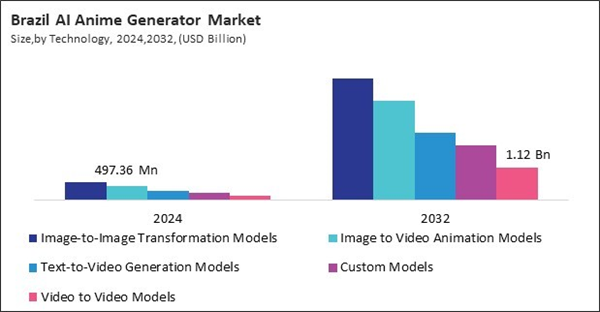The Brazil market dominated the LAMEA AI Anime Generator Market by country in 2024, and is expected to continue to be a dominant market till 2032; thereby, achieving a market value of $13.01 billion by 2032. The Argentina market is showcasing a CAGR of 30.2% during 2025-2032. Additionally, the UAE market would register a CAGR of 28% during 2025-2032.
From a corporate adoption standpoint, animation and game studios are integrating AI-based anime generation into their creative toolkits as a supplement rather than a replacement for traditional methods. AI tools are particularly useful for ideation phases, where hundreds of character design variations can be generated in minutes, expediting the prototyping process. Additionally, studios involved in mobile game development, particularly in markets like South Korea, Japan, and China, are embedding AI-generated art to create diverse cosmetic items and characters, thereby increasing the variety of in-game content without proportionate increases in development time or cost.
When it comes to usage, these anime generators are employed both as end-to-end solutions and as components of a larger production pipeline. For instance, an artist may use an AI tool to generate a base image or character pose and then refine it manually using digital painting software. Conversely, some users rely entirely on AI to create finished assets for digital cards, NFTs, or social media content. In web-based storytelling formats like webtoons and light novels, AI-generated illustrations are being used to enhance textual content, helping authors and publishers produce visually rich narratives with minimal resources.
The LAMEA (Latin America, Middle East, and Africa) region is experiencing a significant surge in the adoption of AI-driven anime generation technologies. This growth is propelled by advancements in machine learning models, increased internet penetration, and a burgeoning digital creative community. These anime generators, which utilize Generative Adversarial Networks (GANs), transformers, and Variational Autoencoders (VAEs), are democratizing animation creation, allowing users to produce high-quality anime-style content without extensive artistic training.
This technological evolution is fostering new avenues for content creation, entertainment, and cultural expression across the LAMEA region. Saudi Arabia is projected to lead the Middle East in AI anime generation. The country's Vision 2030 initiative emphasizes technological innovation and digital transformation, driving investments in AI infrastructure. Collaborations between the government and tech companies are fostering the development of AI tools tailored to the Saudi market. Moreover, the increasing popularity of anime and gaming culture among Saudi youth is contributing to the demand for AI-generated anime content.
In summary, the LAMEA region is witnessing a dynamic evolution in this market, driven by technological advancements, cultural factors, and supportive policies. In conclusion, LAMEA is emerging as a dynamic market for AI anime generators, propelled by rising digital infrastructure, growing youth engagement, and supportive governmental policies, with Brazil, UAE, and Saudi Arabia leading regional growth through localized innovation and cultural adaptation.
List of Key Companies Profiled
- CyberLink Corporation
- Runway AI, Inc.
- Reallusion Inc.
- Krikey Inc.
- Live3D Limited (AnimeGenius)
- Artvy.ai
- Apple, Inc.
- NightCafe Studio Pty Ltd
- Waifu Labs
- Fotor
Market Report Segmentation
By Platform
- Web-based
- App-based
By Application
- Content Creation
- Merchandising
- Other Application
By Technology
- Image-to-Image Transformation Models
- Image to Video Animation Models
- Text-to-Video Generation Models
- Custom Models
- Video to Video Models
By End User
- Individual Creators
- Animation Studios
- Game Developers
- Advertising & Marketing Agencies
- Other End User
By Country
- Brazil
- Argentina
- UAE
- Saudi Arabia
- South Africa
- Nigeria
- Rest of LAMEA
Table of Contents
Companies Mentioned
- CyberLink Corporation
- Runway AI, Inc.
- Reallusion Inc.
- Krikey Inc.
- Live3D Limited (AnimeGenius)
- Artvy.ai
- Apple, Inc.
- NightCafe Studio Pty Ltd
- Waifu Labs
- Fotor









